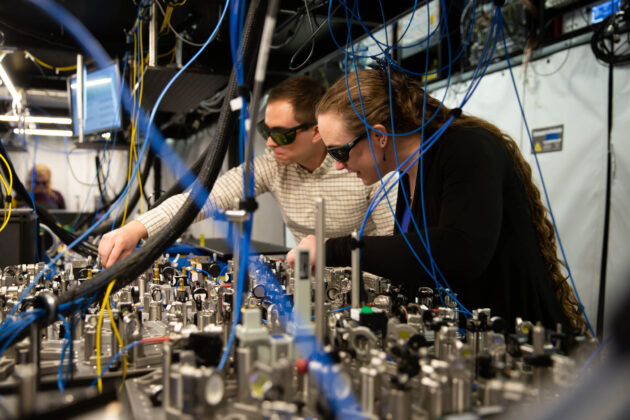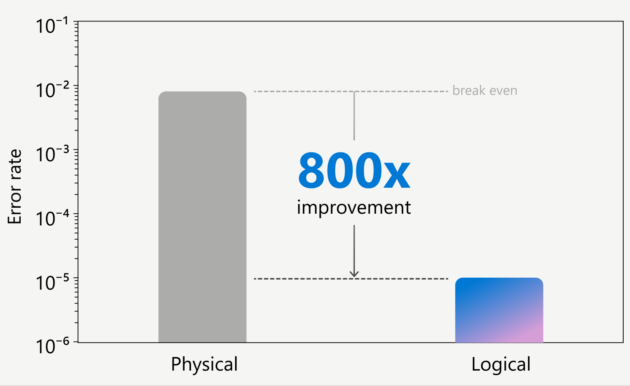
Microsoft and Quantinuum say they’ve demonstrated a quantum computing system that can reduce the error rate for data processing by a factor of 800.
“Today signifies a major achievement for the entire quantum ecosystem,” Jason Zander, Microsoft’s executive vice president for strategic missions and technologies, said in a blog posting about the achievement.
Quantum computing could solve certain types of problems — ranging from data encryption and system optimization to the development of new synthetic materials — on a time scale that would be unachievable using classical computers. “Scaled quantum computers would offer the ability to simulate the interactions of molecules and atoms at the quantum level beyond the reach of classical computers, unlocking solutions that can be a catalyst for positive change in our world,” Zander said.
The secret to success lies in quantum bits, or qubits, that can represent multiple values until the results of a computation are read out. Qubits typically make use of exotic materials, such as superconducting circuits, diamonds with defects or laser-cooled ions.
One big challenge is that qubits tend to be “noisy” — that is susceptible to perturbations that introduce errors. For years, researchers have been hunting for ways to maintain the fidelity of qubits and correct any errors that arise. Such strategies typically involve linking up multiple physical qubits to represent a single “logical qubit.”
Just a couple of years ago, Microsoft researchers were saying that a quantum computer would need at least a million physical qubits in order to demonstrate an advantage over classical computers. But that’s because it was thought that thousands of physical qubits would be required to produce a single logical qubit. If fewer physical qubits are required for error correction, that would make it easier to build useful quantum computers.
The newly reported demonstration addresses that challenge: Microsoft and Quantinuum said they created four highly reliable logical qubits from just 30 physical qubits.
“With this system, we ran more than 14,000 individual experiments without an error,” Zander said.
In a technical blog posting, Microsoft’s Dennis Tom and Krysta Svore wrote that they used a qubit-virtualization system to improve the reliability of Quantinuum’s ion-trap hardware by a factor of 800. Tom is general manager of Azure Quantum, and Svore is Microsoft’s vice president of advanced quantum development.

“An 800x improvement in error rate corresponds to a 29 dB improvement of signal, which is the same as that achieved with a high-quality noise-canceling headset,” Tom and Svore said.
The comparison is particularly apt: “Activating the noise-canceling function on the headphones to listen to music, while removing most of the environmental noise, is akin to applying our qubit-virtualization system,” the researchers said.
Microsoft takes a hybrid approach to cloud-based computing, which combines the strengths of classical supercomputing and quantum processing. Zander said the application of Microsoft’s qubit-virtualization system “moves us out of the current noisy intermediate-scale quantum (NISQ) level to Level 2 Resilient quantum computing.”
“Advanced capabilities based on these logical qubits will be available in private preview for Azure Quantum Elements customers in the coming months,” he said.
Microsoft is already looking ahead to the next level.
“At Level 3, we expect to be able to solve some of our most challenging problems, particularly in fields like chemistry and materials science, unlocking new applications that bring quantum at scale together with the best of classical supercomputing and AI — all connected in the Azure Quantum cloud,” Zander said.
Microsoft isn’t the only tech company reporting progress on the quantum frontier. Here’s a roundup of other recent developments in the field:
- Amazon Web Services says it has demonstrated a new type of qubit that converts most of the errors encountered during data processing into a class of errors called “erasure errors.” Erasure error detection and correction can lead to significant reductions in error-correction overhead, AWS says. “Long-term, this could potentially mean you may only need 100 physical qubits to make up one logical qubit vs. the 1,000 physical qubits per logical qubit today,” an Amazon spokesperson told GeekWire in an email.
- IonQ says it has entered into a strategic agreement with South Carolina Quantum to provide quantum computing capabilities and services to its partners, including academic institutions. IonQ and South Carolina Quantum will partner to develop training courses and accelerate the introduction of quantum technologies in the Palmetto State. IonQ’s HQ is in Maryland, but in February, the company officially opened a facility for developing and manufacturing quantum computers in Bothell, Wash.
- IBM says it has created an error-correcting code that’s about 10 times more efficient than previous methods. The computational architecture is called “the gross code” because of its connections to the mathematical term for a dozen dozen (12 x 12, or 144). The code requires 144 qubits to store data, and another 144 qubits to check for errors. The resulting 288-qubit array can protect 12 logical qubits for roughly a million cycles of error checks. IBM’s research made the cover of last week’s issue of Nature.

